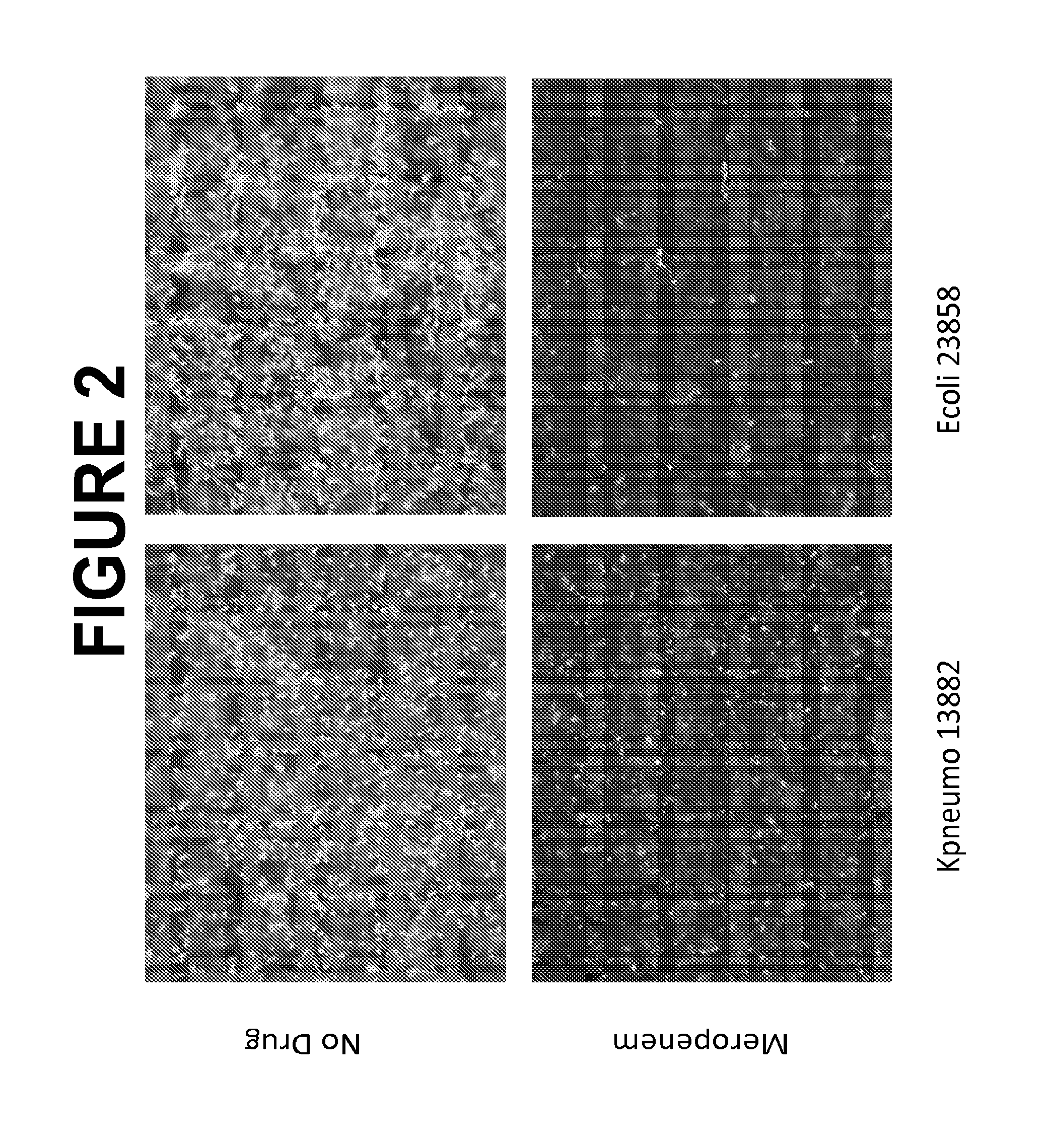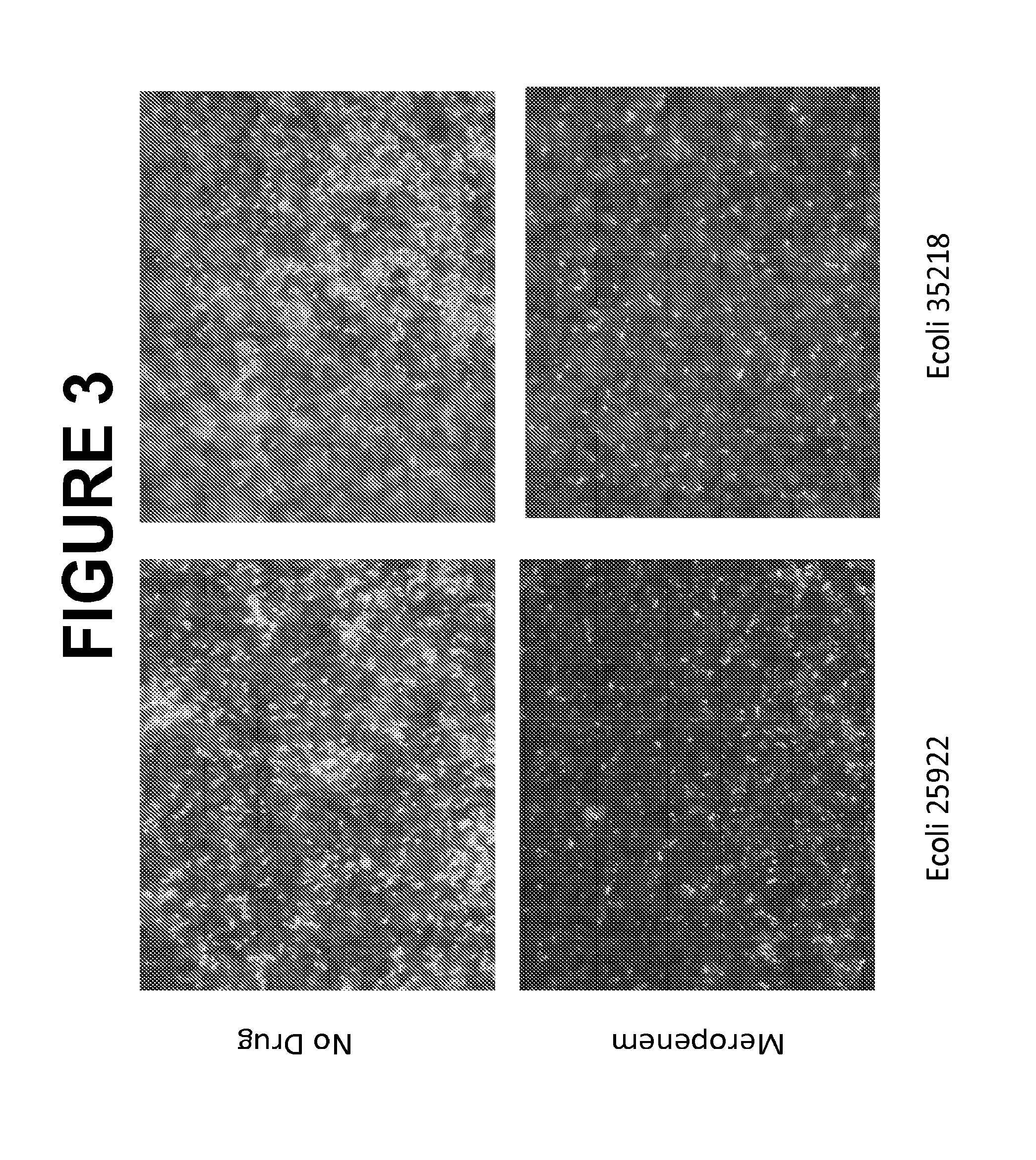Antimicrobial compound susceptibility test
a technology of susceptibility test and antimicrobial compound, which is applied in the field of antimicrobial compound susceptibility test, can solve the problems of increasing mortality, morbidity, and health care costs, and reducing the treatment options of resistant pathogens
- Summary
- Abstract
- Description
- Claims
- Application Information
AI Technical Summary
Benefits of technology
Problems solved by technology
Method used
Image
Examples
example 1
Selective Lysis of Susceptible Bacteria Exposed to Meropenem
[0243]An isolated colony from an overnight Tryptocase Soy Agar (TSA) plate of each bacterial strain was suspended in 1 ml Tryptocasc Soy Broth (TSB) in a 5 ml BD polystyrene round bottom tube. TSB cultures were incubated shaking at 37° C. overnight. Ten of the overnight culture was inoculated into lml TSB and incubated shaking at 37° C. for three hours. Two 2500 aliquots of each log-phase culture were then transferred to two 2 ml Eppendorf microcentrifuge tubes. One tube contained 5000 of Normal Saline (BD); the second tube contained 5000 Normal Saline with meropenem at 10 μg / ml (final concentration of meropenem of 6.67 10 μg / ml). Tubes were inverted and then incubated at 37° C. stagnant for thirty minutes. Then 2500 of lysis buffer (0.5% SDS in PSB) (final concentration of SDS of 0.125%) was added to each tube and the tubes were vortexed for 5 seconds. Post incubation, all tubes were spun at 10000 G for 5 minutes. Supernat...
example 2
Selective Lysis of Bacteria Exposed to Meropenem and Cefotaxime
[0250]In this experiment the following strains were tested: strain K. pneumoniae 13882 (previously considered meropenem sensitive and cefotaxime sensitive); E. coli BAA-197 (ESBL) (which expresses an extended-spectrum (beta)-lactamase enzyme and was previously considered meropenem sensitive and cefotaxime resistant); K. pneumoniae BAA-1705 (KPC) (which expresses a carbapenemase enzyme and was previously considered meropenem resistant and cefotaxime resistant); and K. pneumoniae BAA-2146 (NDM1) (which expresses the metallo-beta-lactamase-1 enzyme and was previously considered meropenem resistant and cefotaxime resistant).
[0251]An isolated colony from an overnight Tryptocase Soy Agar (TSA) plate of each bacteria was suspended in 1 ml Tryptocase Soy Broth (TSB) in a 5 ml BD polystyrene round bottom tube. TSB cultures were incubated at 37° C. for 1.5 hours shaking. Three 250 μl aliquots of each stationary-phase culture were ...
example 3
Selective Lysis of Bacteria Exposed to Meropenem
[0254]An alternative to the spectrophotometer-based measurement of changes in turbidity for measuring cell lysis following treatment with the cell lysis conditions in Examples 1 and 2 is to stain samples using a stain that distinguishes between intact cells and lysed cells. In this example staining with BacUni QuickFISH™ was used to identify intact (i.e., non-lysed) cells. BacUN1 is a universal bacteria PNA probe that binds to an rRNA sequence present in most Gram-positive and Gram-negative bacteria. The PNA probe binds to universal rRNA in intact bacterial cells and the entire cell will appears green with fluorescent microscopy. If the bacterial cell had been lysed then the rRNA target would have been released from the bacterial cell and even of somewhat labeled it would not appear as a fluorescent bacterial cell.
[0255]An isolated colony from an overnight Tryptocase Soy Agar (TSA) plate of each bacteria was suspended in 1 ml Tryptocas...
PUM
| Property | Measurement | Unit |
|---|---|---|
| Time | aaaaa | aaaaa |
| Time | aaaaa | aaaaa |
| Fraction | aaaaa | aaaaa |
Abstract
Description
Claims
Application Information
 Login to View More
Login to View More - R&D
- Intellectual Property
- Life Sciences
- Materials
- Tech Scout
- Unparalleled Data Quality
- Higher Quality Content
- 60% Fewer Hallucinations
Browse by: Latest US Patents, China's latest patents, Technical Efficacy Thesaurus, Application Domain, Technology Topic, Popular Technical Reports.
© 2025 PatSnap. All rights reserved.Legal|Privacy policy|Modern Slavery Act Transparency Statement|Sitemap|About US| Contact US: help@patsnap.com



